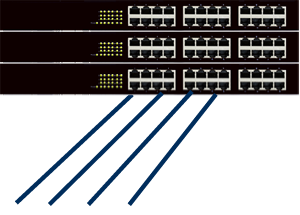1-Armed Single Network is used when the WebMux must act as a proxy on the same subnet as the servers (no NAT).
WebMux and servers are on the same network


The IPMI Port on the A500X, A500XD, and A600X models provides:
• Remote Power On and Power Off
• Remote console for troubleshooting
• IPMI data such as temp and fan speeds for data center operators who use IPMI

The MGMT port provides WebMux configuration LAN access. This separate port allows out-of-band management - separate from the LAN ports used for load-balancing functions.


The BACKUP port is used for High Availability (HA) failover communication for a pair of WebMux configuration

1-Armed Single Network means that the client traffic comes into the WebMux, is load-balanced across the back-end servers, and the traffic goes back through the WebMux to the original client.
One connection or all four may be used, depending on the switch and its configuration options.
NETWORK TRAFFIC PORTS are, by default, configured as one aggregated link (LAG, "Etherchannel," etc.) to
provide maximum throughput.
IPMI, MGMT, BACKUP, and NETWORK TRAFFIC PORTS
Click each to toggle a description


Client traffic is routed to the Farm/Virtual IP address on the WebMux, which load-balances between servers:
• The WebMux terminates the TCP or UDP connection.
• The WebMux becomes the client to the load-balanced servers at the back end.
• The servers reply to the WebMux.
• The WebMux replies to the client.
1-Armed Single Network mode has the WebMux terminating the client connection and establishing a separate connection to the back end (Source-NATting / SNAT).
This approach can eliminate some routing concerns since the client appears to be the WebMux.
The connection termination and creation has an impact on performance and resources.
The WebMux will need additional IP addresses on the "Server LAN" for each 65,535 simultaneous connections that it needs to supports.